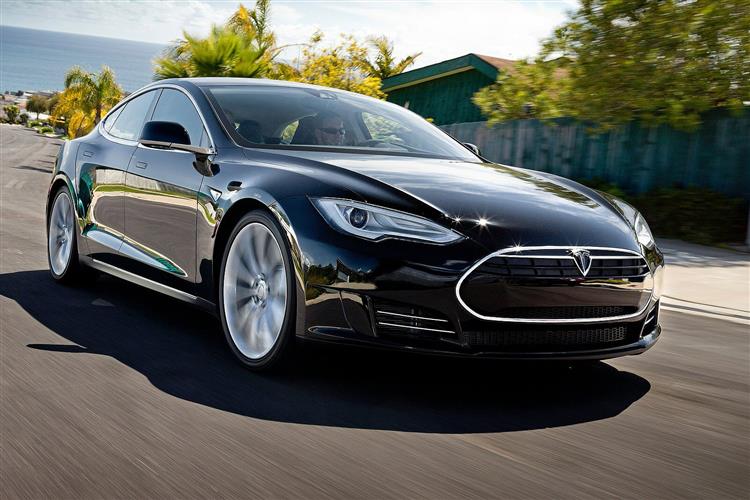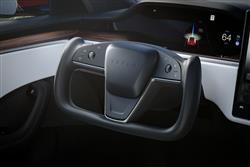AN S THAT IMPRESSED (some text hidden) --NONE--
By Jonathan Crouch
Introductionword count: 58
Launched in the UK in 2019, the Model 3 was Tesla's more significant car to date, mainly because it was the company's most affordable product. It's all-electric of course and in Dual Motor form offered industry-leading EV driving range. It was also the company's first four-door design. Here we look at the pre-facelift 2019-2023 versions of this car.
Modelsword count: 26
5dr Fastback (EV) [Rear-Wheel Drive, Dual Motor] (60, 60D, 70, 70D, 75, 75D, 85, 85D, P85+, P85D, 90, 90D, P90, 100D AND P100D, Performance, Performance Ludicrous]
Historyword count: 410
Would it be too much to call Tesla's Model S a 'game changer'? We don't think so. Back in 2012, this car launched what is now the world's best known automotive EV brand on an unsuspecting world. It shocked the established brands into getting on with the electric era. And it was a luxury executive EV benchmark that others aspired to for nearly a decade, originally engineered with a goal of creating the best car in the world. Top European saw this car and had to quickly follow suit to properly challenge what was the most important car America had brought us since Henry Ford's original Model T. In this Review, we're going to look in detail at just why this Tesla was so significant. Offered typically with up to 300 miles of driving range, it more than trebled the distance that, until 2013, full-EV vehicles had been able to travel between charges. Yet it did so with a turn of speed that embarrassed all but the fastest petrol super-saloons in its era. While operating in a level of silence that'll made a Rolls Royce seem hopelessly unrefined. This was, in short, a car that thought way beyond the box. Like Elon Musk, Tesla brand co-creator and co-founder of a Pay Pal organisation that gave him such reserves of operating capital that he could afford to spend as much as was necessary to create a sustainable automotive future that started with this car. As the century's second decade wore on, Tesla introduced a confusingly large number of Model S variants with number to identify them. These included 60, 60D, 70, 70D, 75, 75D, 85, 85D, P85+, P85D, 90, 90D, P90, 100D and P100D versions. The numbers signified the kWh (kilowatt-hour) rating of the lithium-ion battery pack, with a larger number signifying extra power and longer range. The D identifier meant Dual Motor, so was applied to the four-wheel-drive variants. The range-topper was the 'Performance' version. The Model S was lightly facelifted in 2016 (the main change being the deletion of the fake front grille). Here, we look at the earlier 2013-2020 Model S variants, cars which sold until 2021, right hand drive production having ceased the year before. The car then left sale in the UK until 2022, when Tesla introduced a heavily updated version of the same design which was only offered with left hand drive. It's the earlier 2013-2020 version of the Model S we look at here.
What You Getword count: 596
If you're of the opinion that futuristic technology should come in futuristic packaging, then you might find the styling of this Model S to be surprising conventional. It's certainly the kind of look that a buyer in the luxury segment would be used to, but only because Tesla wisely chose to follow customer expectations in making it so. It's quite handsome though, the exterior shape being the work of ex-Mazda designer Franz von Holzhausen, who previously worked on the New Beetle and the Pontiac Solstice sports car. It's hard to see those influences here, but there are certainly plenty of others - from different angles, you might be reminded of anything from an Aston Martin Rapide or a Jaguar XJ to an Audi Q7. What matters is that, as a total package, there's probably something to please almost everyone. Drop inside and the surprises keep on coming throughout a beautifully-trimmed interior in which the designers clearly felt free to be a little more futuristic. Look around the dash and you'll spot only a couple of buttons - one for the glovebox, the other for the hazard flashers. Otherwise, just about everything is controlled by a huge 17-inch colour touchscreen that dominates the fascia. It's just as well then, that the interface it offers is brilliant, dealing effectively with everything from the air conditioning controls to stereo functions and the various settings for things like the car's suspension settings and the regenerative braking modes. Primarily though, you'll probably mostly be leaving this middle screen in its 'Navigation' display setting - in which form it really is clever. Thanks to a 3G (later 4G) Google Maps connection, it can show you traffic build-up points and Google Earth images. Plus of course, it's the point from which you'll be planning your journeys, with displays predicting the percentage of battery charge that'll remain at your required destination - and the amount you'll be left with upon returning home. As for rear seat accommodation, well the standards of head and legroom on offer are unremarkable for a car in this class, but what is impressive is this car's ability to comfortably look after three fully-sized adults in a way that no other rival in this class can. The lack of the usual centrally-placed rear transmission tunnel helps in this, as does the shaping of a rear bench that's properly formed for a middle occupant, rather than confining them to a perch on an uncomfortably raised cushion. And cargo space? Well there's plenty of it. The lack of an engine means that the pointy end gets what Tesla calls a 'frunk'(American for 'front trunk', you see). Flip the bonnet and there's 150-litres on offer - or at least there is in this rear wheel drive model. Go for the 'All-Wheel Drive Dual Motor' version and this space behind the cargo net is taken care of by the front-mounted motor. The 4WD drivetrain requires a slight compromise in rear boot space too, but it's not hugely significant and in any case, there's plenty of room to play with. This rear-driven version offers 744-litres, which is about 50% more than you'd get in a rival Mercedes S-Class of this era, or even something like a Volvo V70 estate with all the seats in use. There's so much space in fact that Tesla offered a pair of occasional-use rearward-facing child seats as an option, neatly folding out from the boot floor; almost nobody in the UK took this option up. Fold forward the 60/40 split-folding rear bench and there's 1,645-litres of space to play with.
To see the full road test text contact us on 0330 0020 227
Pictures (high res disabled)

.jpg)
|
.jpg)
|
.jpg)
| |||

|
Scoring (subset of scores)
Category: Hybrid, Plug-in, Electric & Hydrogen
| Performance | |
| Handling | |
| Comfort | |
| Space | |
| Styling, Build, Value, Equipment, Depreciation, Handling, Insurance and Total scores are available with our full data feed. | |



